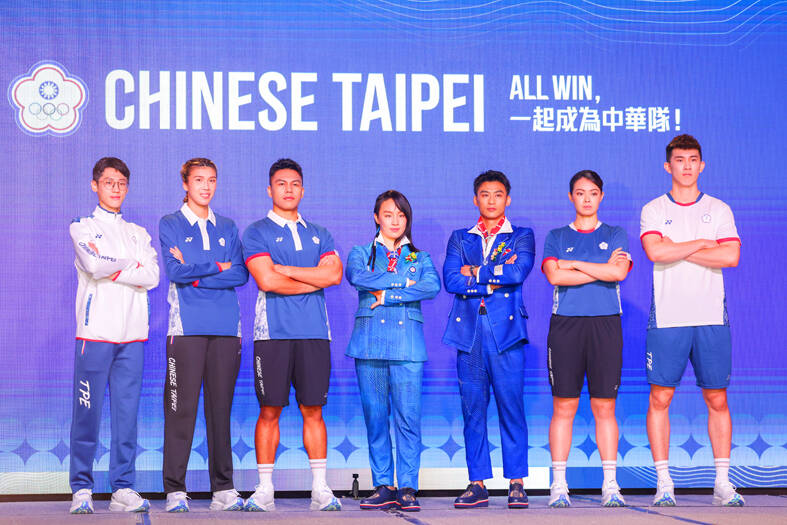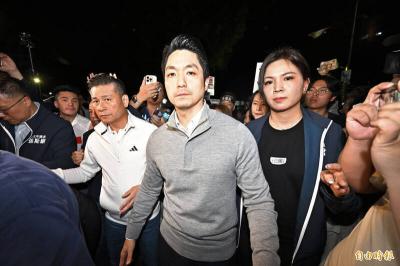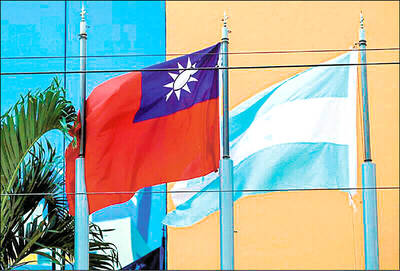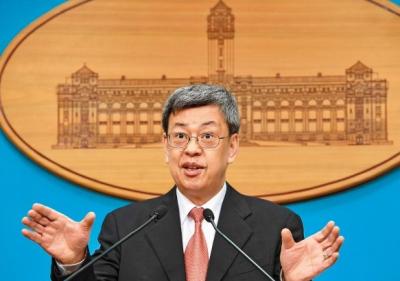Unlike most countries, Taiwan cannot use its country’s own name to compete in the Olympic Games or other major international sports events.
Instead, it participates under the name “Chinese Taipei,” a name that causes confusion and sparks curiosity among many people, including an American director who explored the topic in his new documentary.
Garret Clarke, the director of the 20-minute documentary What’s in a Name? A Chinese Taipei Story, said in an recent media interview said that he was motivated to make the documentary because he finds the name “Chinese Taipei” to be “weird.”

Photo: CNA
The dispute that eventually created the name dates back to the Chinese Civil War, which resulted in the establishment of the People’s Republic of China (PRC) by the Chinese Communist Party on Oct. 1, 1949, and the retreat of the Republic of China (ROC) government to Taiwan.
With both claiming to represent China, the PRC and the ROC posed a challenge for the International Olympic Committee (IOC), which initially recognized the ROC, as did most of the international community.
In 1952, the IOC allowed both the PRC and the ROC to participate in the Helsinki Olympics, but the ROC rejected this dual recognition and withdrew its team’s participation, enabling the PRC to compete in the Olympics for the first time.
Four years later in Melbourne, the PRC and the ROC (participating under the name “Formosa-China”) both sent delegations, but the PRC later withdrew in protest over the ROC flag being raised in the Olympic Village.
The PRC stayed away from the Olympics throughout the 1960s and early 1970s, enabling the ROC to compete under the name of “Formosa” in 1960, “Taiwan” in 1964 and 1968, and “Republic of China” in 1972.
During that era, the Chinese Nationalist Party (KMT) leaders of the ROC wanted the national Olympic team to compete under the name “Republic of China” to get international backing for the ROC’s legitimacy. For the KMT, this was especially important after the UN recognized the PRC as the only legitimate representative of China and expelled the ROC in 1971.
In 1976, the ROC delegation was invited to compete in the Olympic Games under the name “Taiwan” instead of “Republic of China,” but it refused and withdrew from the games in Canada.
In 1979, the IOC executive committee passed the “Nagoya Resolution,” which recognized the PRC’s Olympic Committee as the “Chinese Olympic Committee” and the ROC’s Olympic Committee as the “Chinese Taipei Olympic Committee.”
However, the ROC boycotted the Moscow Olympics in 1980 and did not compete at the games until the 1984 Sarajevo Winter Games after it signed an agreement with the IOC in Lausanne, Switzerland, in 1981.
The “Lausanne agreement” — viewed by some as a compromise by Taiwan — required Taiwan’s team to compete under the name “Chinese Taipei,” use a non-political flag and not play the ROC national anthem.
“Taiwanese wish we could have our own country’s name to show at sports events,” said one of more than 20 Taiwanese interviewed for the documentary in Taipei in January.
Another person said that Taiwan has been suppressed on the international stage and therefore has had to “succumb to these conditions.”
Although the Chinese Taipei name is not popular, when the nation held a referendum in 2018 which asked the public if they agreed Taiwanese athletes should use “Taiwan” when competing in the Tokyo Olympics and all international sporting events, 52.3 percent of voters rejected the idea.
Many reasons led to the referendum result, said Chris Horton, a Taiwan-based journalist.
“Most people didn’t want to rock the boat and find out that now we can’t compete in the Olympics,” he added.
Chu Mu-yen (朱木炎), the first male athlete from Taiwan to win an Olympic gold medal (in 2004), said the Taiwanese delegation could not have easily changed or given up the name “Chinese Taipei,” as the IOC would have seen it as contravening its rules.
“If we could not participate, what would happen to the athletes? They all work so hard,” Chu said. “If we changed the name, but could not participate, the name would have no meaning.”
Having lived in Taiwan for 18 years, the 41-year-old director said he wanted to help people understand that China’s soft power influence over Taiwan persists, which is demonstrated by the nation still using “Chinese Taipei” to compete in the Olympic Games.
With this year’s Paris Olympics set to begin yesterday, Clarke said he hoped that sports fans who see Taiwanese athletes and are intrigued by the name “Chinese Taipei” would “Google it and find this video as the answer.”

Several Chinese Nationalist Party (KMT) officials including Chairman Eric Chu (朱立倫) are to be summoned for questioning and then transferred to prosecutors for holding an illegal assembly in Taipei last night, the Taipei Police said today. Chu and two others hosted an illegal assembly and are to be requested to explain their actions, the Taipei City Police Department's Zhongzheng (中正) First Precinct said, referring to a protest held after Huang Lu Chin-ju (黃呂錦茹), KMT Taipei's chapter director, and several other KMT staffers were questioned for alleged signature forgery in recall petitions against Democratic Progressive Party (DPP) legislators. Taipei prosecutors had filed

Taiwan would welcome the return of Honduras as a diplomatic ally if its next president decides to make such a move, Minister of Foreign Affairs Lin Chia-lung (林佳龍) said yesterday. “Of course, we would welcome Honduras if they want to restore diplomatic ties with Taiwan after their elections,” Lin said at a meeting of the legislature’s Foreign Affairs and National Defense Committee, when asked to comment on statements made by two of the three Honduran presidential candidates during the presidential campaign in the Central American country. Taiwan is paying close attention to the region as a whole in the wake of a

President William Lai (賴清德) has appointed former vice president Chen Chien-jen (陳建仁) to attend the late Pope Francis’ funeral at the Vatican City on Saturday on his behalf, the Ministry of Foreign Affairs said today. The Holy See announced Francis’ funeral would take place on Saturday at 10am in St Peter’s Square. The ministry expressed condolences over Francis’ passing and said that Chen would represent Taiwan at the funeral and offer condolences in person. Taiwan and the Vatican have a long-standing and close diplomatic relationship, the ministry said. Both sides agreed to have Chen represent Taiwan at the funeral, given his Catholic identity and

NEW WORLD: Taiwan is pursuing innovative approaches to international relations through economics, trade and values-based diplomacy, the foreign minister said Taiwan would implement a “three-chain strategy” that promotes democratic values in response to US tariffs, Minister of Foreign Affairs Lin Chia-lung (林佳龍) said. Taiwan would aim to create a “global democratic value chain,” seek to capitalize on its position within the first island chain and promote a “non-red supply chain,” Lin was quoted as saying in the ministry’s written report to the Legislative Yuan submitted ahead of the legislature’s Foreign Affairs and National Defense Committee meeting slated for today. The Ministry would also uphold a spirit of mutual beneficial collaboration, maintaining close communication and consultations with Washington to show that Taiwan-US cooperation